Analysis of Tuberculosis: Incidence, Prevalence, and Determinants
VerifiedAdded on 2022/08/19
|7
|1564
|10
Report
AI Summary
This report provides a comparative analysis of tuberculosis (TB) in Australia and Peru, focusing on incidence and prevalence rates. The report defines and differentiates between incidence and prevalence, highlighting that prevalence measures the number of existing cases in a population at a specific time, while incidence reflects the risk of contracting the disease. In Australia, the report cites an incidence rate of 6.6 per 100,000 people in 2018, with homelessness, cigarette smoking, and overseas birth being significant health determinants. In contrast, Peru experiences a much higher TB burden, including a high incidence of multi-drug resistant TB (MDR-TB), with health determinants being low literacy levels among health professionals. The report concludes by summarizing the key differences in TB epidemiology between the two countries and the factors that contribute to these differences.
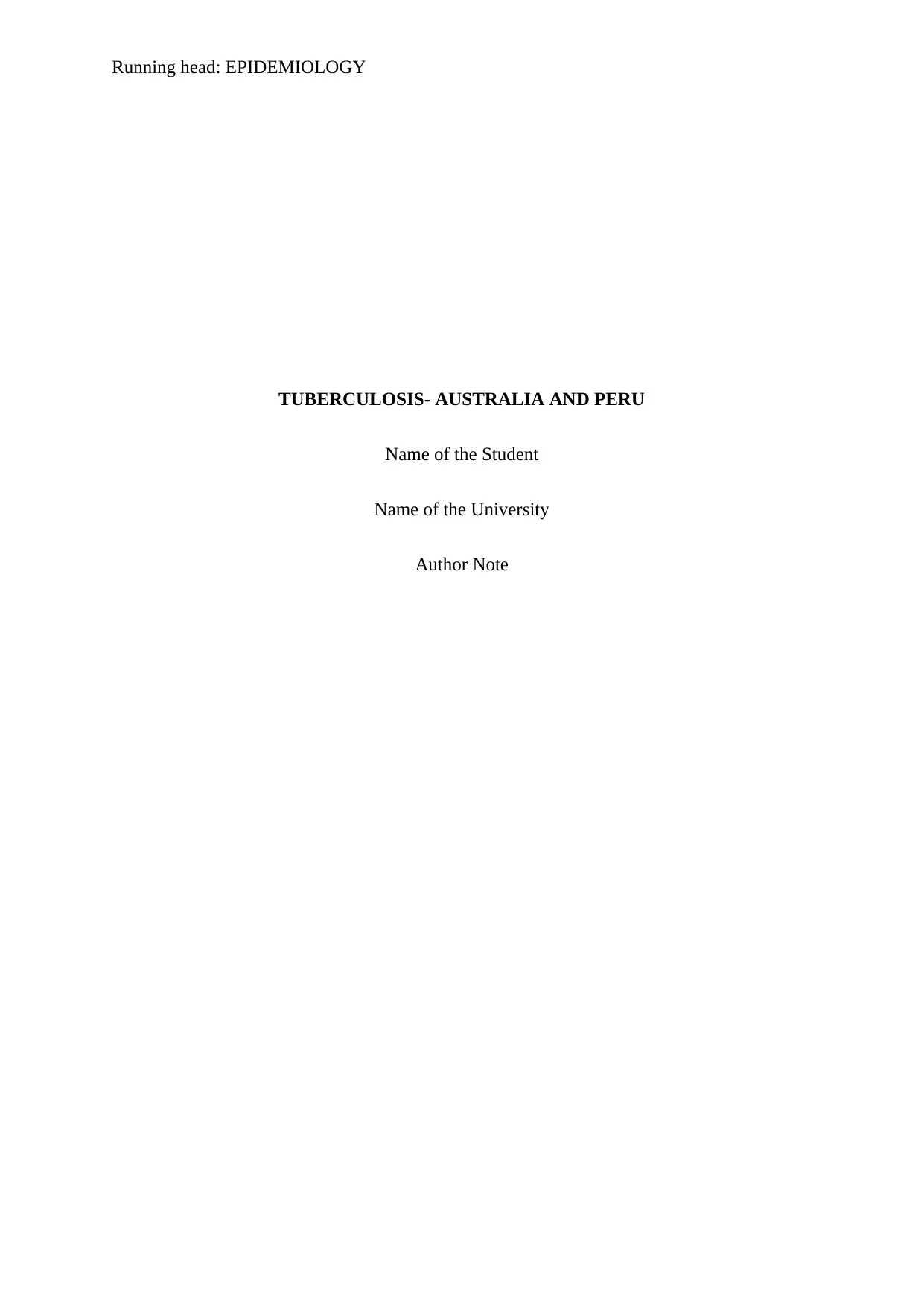
Running head: EPIDEMIOLOGY
TUBERCULOSIS- AUSTRALIA AND PERU
Name of the Student
Name of the University
Author Note
TUBERCULOSIS- AUSTRALIA AND PERU
Name of the Student
Name of the University
Author Note
Paraphrase This Document
Need a fresh take? Get an instant paraphrase of this document with our AI Paraphraser

1EPIDEMIOLOGY
Table of Contents
Answer 1....................................................................................................................................2
Answer 2....................................................................................................................................3
References..................................................................................................................................5
Table of Contents
Answer 1....................................................................................................................................2
Answer 2....................................................................................................................................3
References..................................................................................................................................5
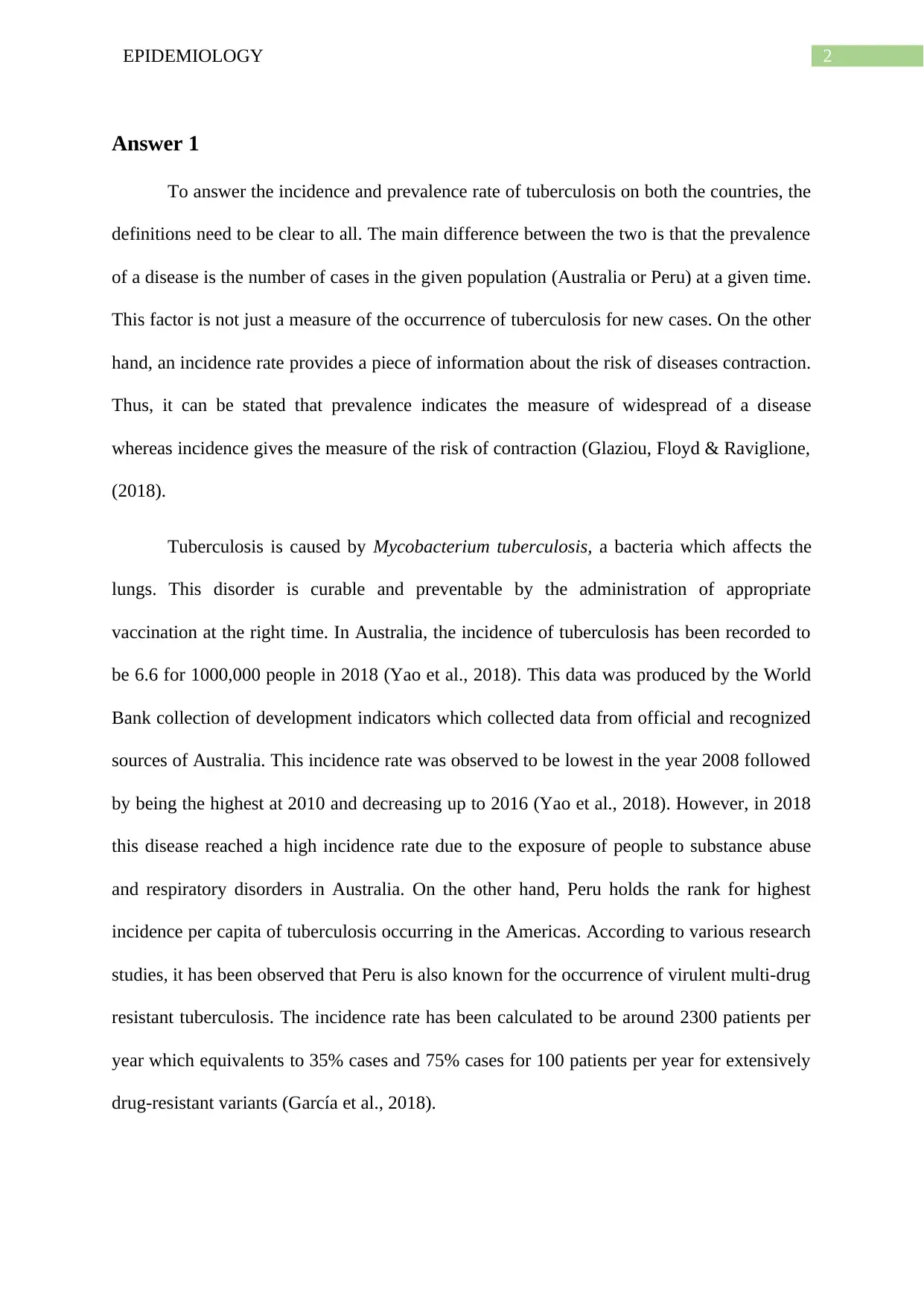
2EPIDEMIOLOGY
Answer 1
To answer the incidence and prevalence rate of tuberculosis on both the countries, the
definitions need to be clear to all. The main difference between the two is that the prevalence
of a disease is the number of cases in the given population (Australia or Peru) at a given time.
This factor is not just a measure of the occurrence of tuberculosis for new cases. On the other
hand, an incidence rate provides a piece of information about the risk of diseases contraction.
Thus, it can be stated that prevalence indicates the measure of widespread of a disease
whereas incidence gives the measure of the risk of contraction (Glaziou, Floyd & Raviglione,
(2018).
Tuberculosis is caused by Mycobacterium tuberculosis, a bacteria which affects the
lungs. This disorder is curable and preventable by the administration of appropriate
vaccination at the right time. In Australia, the incidence of tuberculosis has been recorded to
be 6.6 for 1000,000 people in 2018 (Yao et al., 2018). This data was produced by the World
Bank collection of development indicators which collected data from official and recognized
sources of Australia. This incidence rate was observed to be lowest in the year 2008 followed
by being the highest at 2010 and decreasing up to 2016 (Yao et al., 2018). However, in 2018
this disease reached a high incidence rate due to the exposure of people to substance abuse
and respiratory disorders in Australia. On the other hand, Peru holds the rank for highest
incidence per capita of tuberculosis occurring in the Americas. According to various research
studies, it has been observed that Peru is also known for the occurrence of virulent multi-drug
resistant tuberculosis. The incidence rate has been calculated to be around 2300 patients per
year which equivalents to 35% cases and 75% cases for 100 patients per year for extensively
drug-resistant variants (García et al., 2018).
Answer 1
To answer the incidence and prevalence rate of tuberculosis on both the countries, the
definitions need to be clear to all. The main difference between the two is that the prevalence
of a disease is the number of cases in the given population (Australia or Peru) at a given time.
This factor is not just a measure of the occurrence of tuberculosis for new cases. On the other
hand, an incidence rate provides a piece of information about the risk of diseases contraction.
Thus, it can be stated that prevalence indicates the measure of widespread of a disease
whereas incidence gives the measure of the risk of contraction (Glaziou, Floyd & Raviglione,
(2018).
Tuberculosis is caused by Mycobacterium tuberculosis, a bacteria which affects the
lungs. This disorder is curable and preventable by the administration of appropriate
vaccination at the right time. In Australia, the incidence of tuberculosis has been recorded to
be 6.6 for 1000,000 people in 2018 (Yao et al., 2018). This data was produced by the World
Bank collection of development indicators which collected data from official and recognized
sources of Australia. This incidence rate was observed to be lowest in the year 2008 followed
by being the highest at 2010 and decreasing up to 2016 (Yao et al., 2018). However, in 2018
this disease reached a high incidence rate due to the exposure of people to substance abuse
and respiratory disorders in Australia. On the other hand, Peru holds the rank for highest
incidence per capita of tuberculosis occurring in the Americas. According to various research
studies, it has been observed that Peru is also known for the occurrence of virulent multi-drug
resistant tuberculosis. The incidence rate has been calculated to be around 2300 patients per
year which equivalents to 35% cases and 75% cases for 100 patients per year for extensively
drug-resistant variants (García et al., 2018).
⊘ This is a preview!⊘
Do you want full access?
Subscribe today to unlock all pages.

Trusted by 1+ million students worldwide
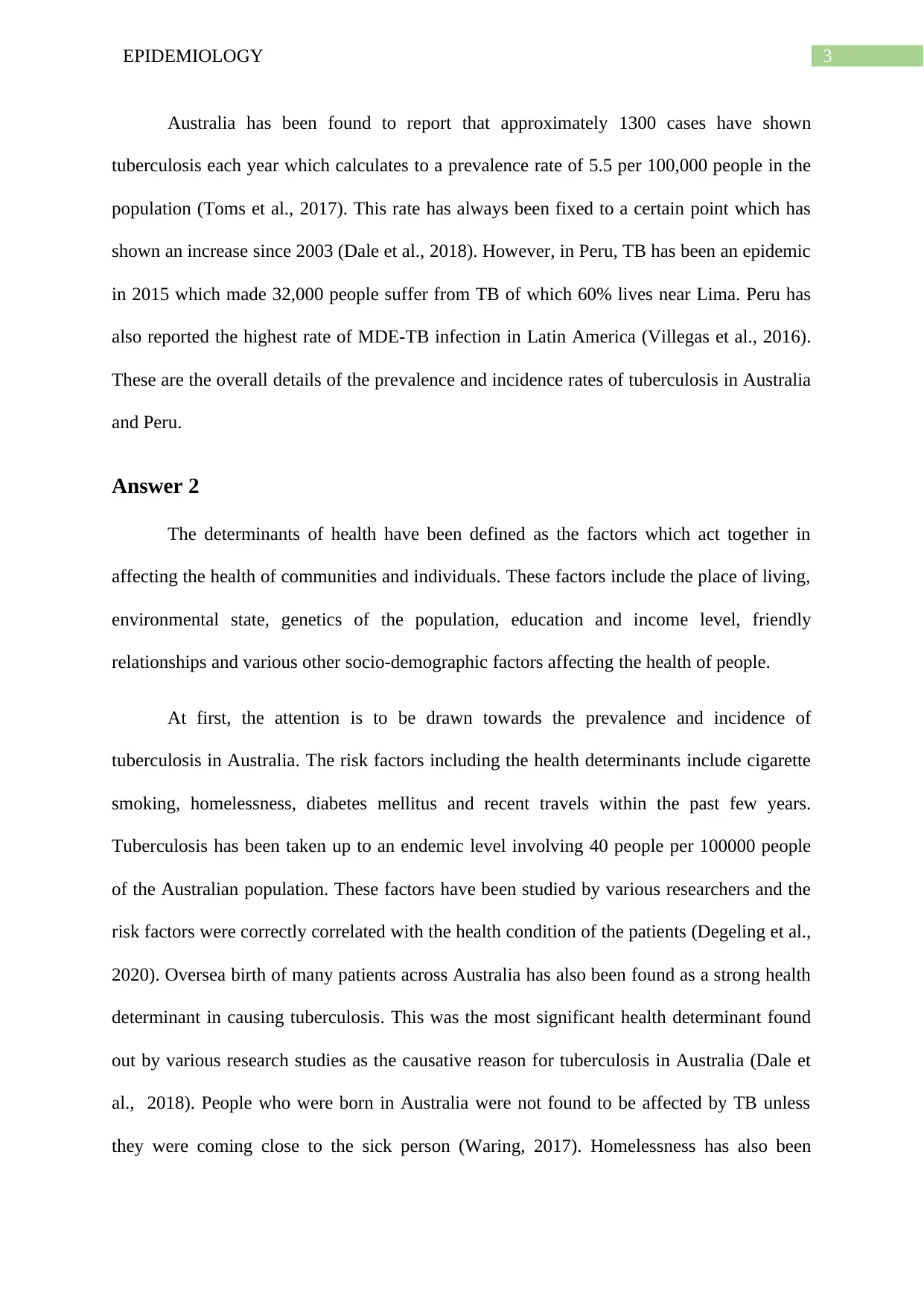
3EPIDEMIOLOGY
Australia has been found to report that approximately 1300 cases have shown
tuberculosis each year which calculates to a prevalence rate of 5.5 per 100,000 people in the
population (Toms et al., 2017). This rate has always been fixed to a certain point which has
shown an increase since 2003 (Dale et al., 2018). However, in Peru, TB has been an epidemic
in 2015 which made 32,000 people suffer from TB of which 60% lives near Lima. Peru has
also reported the highest rate of MDE-TB infection in Latin America (Villegas et al., 2016).
These are the overall details of the prevalence and incidence rates of tuberculosis in Australia
and Peru.
Answer 2
The determinants of health have been defined as the factors which act together in
affecting the health of communities and individuals. These factors include the place of living,
environmental state, genetics of the population, education and income level, friendly
relationships and various other socio-demographic factors affecting the health of people.
At first, the attention is to be drawn towards the prevalence and incidence of
tuberculosis in Australia. The risk factors including the health determinants include cigarette
smoking, homelessness, diabetes mellitus and recent travels within the past few years.
Tuberculosis has been taken up to an endemic level involving 40 people per 100000 people
of the Australian population. These factors have been studied by various researchers and the
risk factors were correctly correlated with the health condition of the patients (Degeling et al.,
2020). Oversea birth of many patients across Australia has also been found as a strong health
determinant in causing tuberculosis. This was the most significant health determinant found
out by various research studies as the causative reason for tuberculosis in Australia (Dale et
al., 2018). People who were born in Australia were not found to be affected by TB unless
they were coming close to the sick person (Waring, 2017). Homelessness has also been
Australia has been found to report that approximately 1300 cases have shown
tuberculosis each year which calculates to a prevalence rate of 5.5 per 100,000 people in the
population (Toms et al., 2017). This rate has always been fixed to a certain point which has
shown an increase since 2003 (Dale et al., 2018). However, in Peru, TB has been an epidemic
in 2015 which made 32,000 people suffer from TB of which 60% lives near Lima. Peru has
also reported the highest rate of MDE-TB infection in Latin America (Villegas et al., 2016).
These are the overall details of the prevalence and incidence rates of tuberculosis in Australia
and Peru.
Answer 2
The determinants of health have been defined as the factors which act together in
affecting the health of communities and individuals. These factors include the place of living,
environmental state, genetics of the population, education and income level, friendly
relationships and various other socio-demographic factors affecting the health of people.
At first, the attention is to be drawn towards the prevalence and incidence of
tuberculosis in Australia. The risk factors including the health determinants include cigarette
smoking, homelessness, diabetes mellitus and recent travels within the past few years.
Tuberculosis has been taken up to an endemic level involving 40 people per 100000 people
of the Australian population. These factors have been studied by various researchers and the
risk factors were correctly correlated with the health condition of the patients (Degeling et al.,
2020). Oversea birth of many patients across Australia has also been found as a strong health
determinant in causing tuberculosis. This was the most significant health determinant found
out by various research studies as the causative reason for tuberculosis in Australia (Dale et
al., 2018). People who were born in Australia were not found to be affected by TB unless
they were coming close to the sick person (Waring, 2017). Homelessness has also been
Paraphrase This Document
Need a fresh take? Get an instant paraphrase of this document with our AI Paraphraser
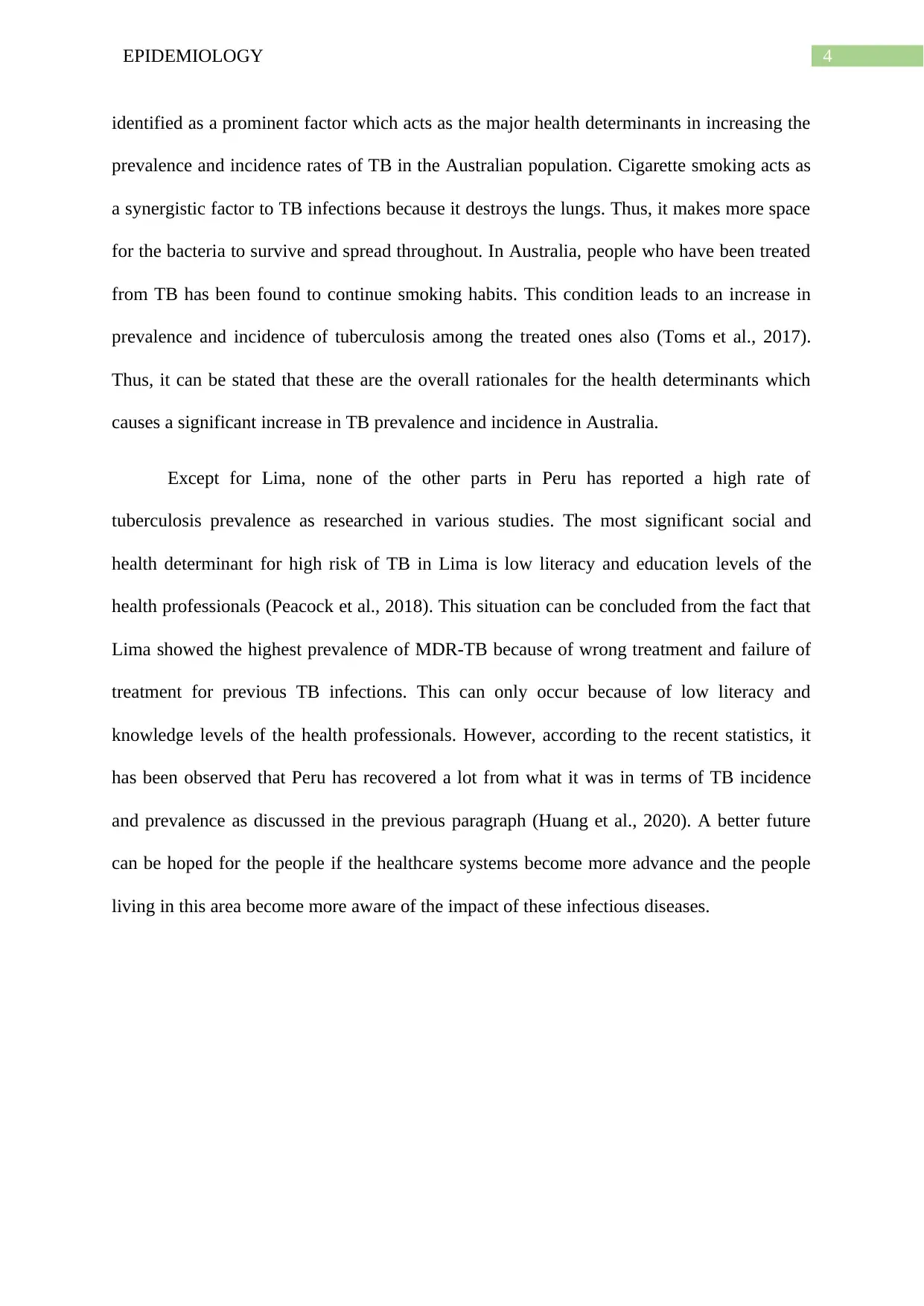
4EPIDEMIOLOGY
identified as a prominent factor which acts as the major health determinants in increasing the
prevalence and incidence rates of TB in the Australian population. Cigarette smoking acts as
a synergistic factor to TB infections because it destroys the lungs. Thus, it makes more space
for the bacteria to survive and spread throughout. In Australia, people who have been treated
from TB has been found to continue smoking habits. This condition leads to an increase in
prevalence and incidence of tuberculosis among the treated ones also (Toms et al., 2017).
Thus, it can be stated that these are the overall rationales for the health determinants which
causes a significant increase in TB prevalence and incidence in Australia.
Except for Lima, none of the other parts in Peru has reported a high rate of
tuberculosis prevalence as researched in various studies. The most significant social and
health determinant for high risk of TB in Lima is low literacy and education levels of the
health professionals (Peacock et al., 2018). This situation can be concluded from the fact that
Lima showed the highest prevalence of MDR-TB because of wrong treatment and failure of
treatment for previous TB infections. This can only occur because of low literacy and
knowledge levels of the health professionals. However, according to the recent statistics, it
has been observed that Peru has recovered a lot from what it was in terms of TB incidence
and prevalence as discussed in the previous paragraph (Huang et al., 2020). A better future
can be hoped for the people if the healthcare systems become more advance and the people
living in this area become more aware of the impact of these infectious diseases.
identified as a prominent factor which acts as the major health determinants in increasing the
prevalence and incidence rates of TB in the Australian population. Cigarette smoking acts as
a synergistic factor to TB infections because it destroys the lungs. Thus, it makes more space
for the bacteria to survive and spread throughout. In Australia, people who have been treated
from TB has been found to continue smoking habits. This condition leads to an increase in
prevalence and incidence of tuberculosis among the treated ones also (Toms et al., 2017).
Thus, it can be stated that these are the overall rationales for the health determinants which
causes a significant increase in TB prevalence and incidence in Australia.
Except for Lima, none of the other parts in Peru has reported a high rate of
tuberculosis prevalence as researched in various studies. The most significant social and
health determinant for high risk of TB in Lima is low literacy and education levels of the
health professionals (Peacock et al., 2018). This situation can be concluded from the fact that
Lima showed the highest prevalence of MDR-TB because of wrong treatment and failure of
treatment for previous TB infections. This can only occur because of low literacy and
knowledge levels of the health professionals. However, according to the recent statistics, it
has been observed that Peru has recovered a lot from what it was in terms of TB incidence
and prevalence as discussed in the previous paragraph (Huang et al., 2020). A better future
can be hoped for the people if the healthcare systems become more advance and the people
living in this area become more aware of the impact of these infectious diseases.
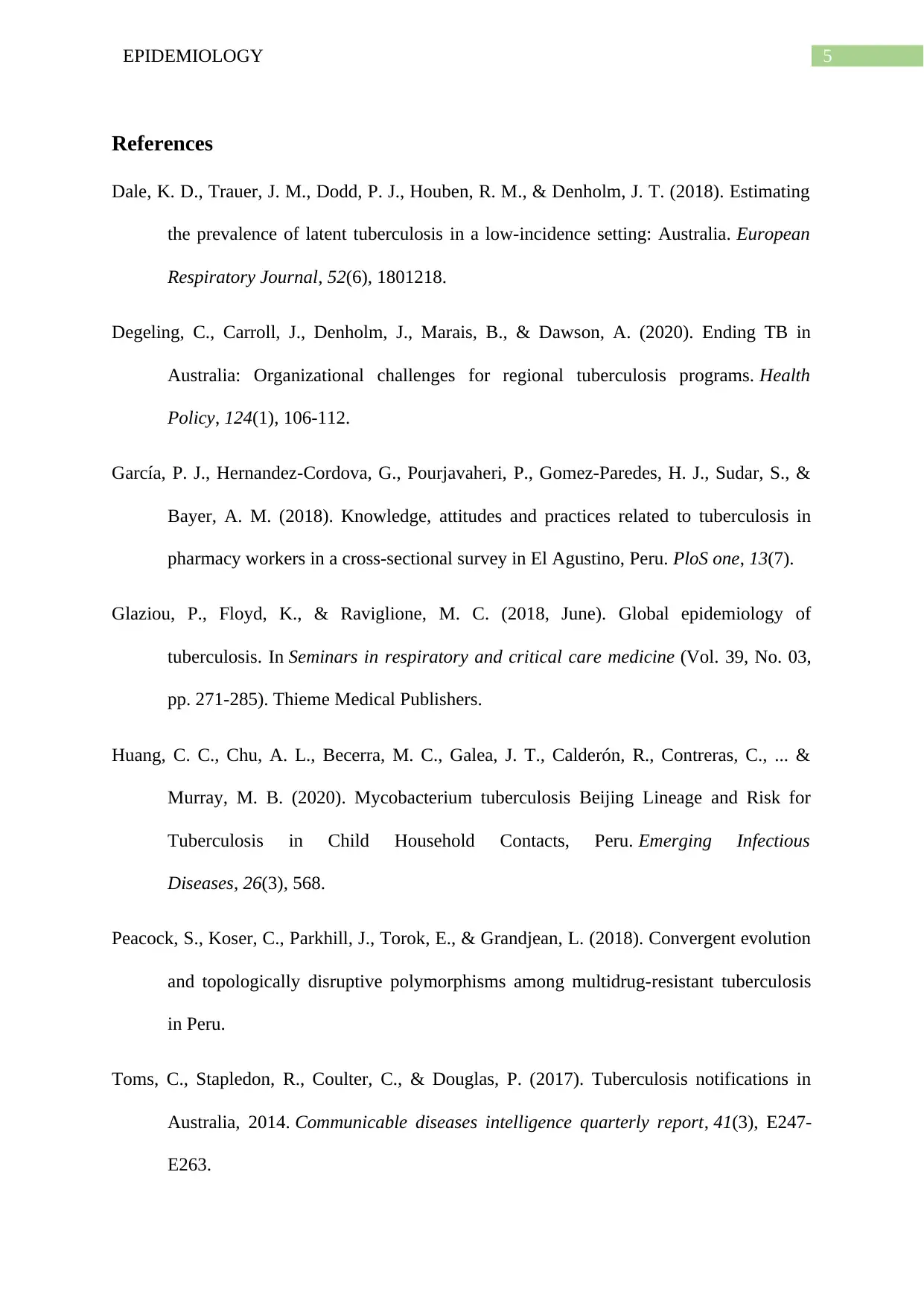
5EPIDEMIOLOGY
References
Dale, K. D., Trauer, J. M., Dodd, P. J., Houben, R. M., & Denholm, J. T. (2018). Estimating
the prevalence of latent tuberculosis in a low-incidence setting: Australia. European
Respiratory Journal, 52(6), 1801218.
Degeling, C., Carroll, J., Denholm, J., Marais, B., & Dawson, A. (2020). Ending TB in
Australia: Organizational challenges for regional tuberculosis programs. Health
Policy, 124(1), 106-112.
García, P. J., Hernandez-Cordova, G., Pourjavaheri, P., Gomez-Paredes, H. J., Sudar, S., &
Bayer, A. M. (2018). Knowledge, attitudes and practices related to tuberculosis in
pharmacy workers in a cross-sectional survey in El Agustino, Peru. PloS one, 13(7).
Glaziou, P., Floyd, K., & Raviglione, M. C. (2018, June). Global epidemiology of
tuberculosis. In Seminars in respiratory and critical care medicine (Vol. 39, No. 03,
pp. 271-285). Thieme Medical Publishers.
Huang, C. C., Chu, A. L., Becerra, M. C., Galea, J. T., Calderón, R., Contreras, C., ... &
Murray, M. B. (2020). Mycobacterium tuberculosis Beijing Lineage and Risk for
Tuberculosis in Child Household Contacts, Peru. Emerging Infectious
Diseases, 26(3), 568.
Peacock, S., Koser, C., Parkhill, J., Torok, E., & Grandjean, L. (2018). Convergent evolution
and topologically disruptive polymorphisms among multidrug-resistant tuberculosis
in Peru.
Toms, C., Stapledon, R., Coulter, C., & Douglas, P. (2017). Tuberculosis notifications in
Australia, 2014. Communicable diseases intelligence quarterly report, 41(3), E247-
E263.
References
Dale, K. D., Trauer, J. M., Dodd, P. J., Houben, R. M., & Denholm, J. T. (2018). Estimating
the prevalence of latent tuberculosis in a low-incidence setting: Australia. European
Respiratory Journal, 52(6), 1801218.
Degeling, C., Carroll, J., Denholm, J., Marais, B., & Dawson, A. (2020). Ending TB in
Australia: Organizational challenges for regional tuberculosis programs. Health
Policy, 124(1), 106-112.
García, P. J., Hernandez-Cordova, G., Pourjavaheri, P., Gomez-Paredes, H. J., Sudar, S., &
Bayer, A. M. (2018). Knowledge, attitudes and practices related to tuberculosis in
pharmacy workers in a cross-sectional survey in El Agustino, Peru. PloS one, 13(7).
Glaziou, P., Floyd, K., & Raviglione, M. C. (2018, June). Global epidemiology of
tuberculosis. In Seminars in respiratory and critical care medicine (Vol. 39, No. 03,
pp. 271-285). Thieme Medical Publishers.
Huang, C. C., Chu, A. L., Becerra, M. C., Galea, J. T., Calderón, R., Contreras, C., ... &
Murray, M. B. (2020). Mycobacterium tuberculosis Beijing Lineage and Risk for
Tuberculosis in Child Household Contacts, Peru. Emerging Infectious
Diseases, 26(3), 568.
Peacock, S., Koser, C., Parkhill, J., Torok, E., & Grandjean, L. (2018). Convergent evolution
and topologically disruptive polymorphisms among multidrug-resistant tuberculosis
in Peru.
Toms, C., Stapledon, R., Coulter, C., & Douglas, P. (2017). Tuberculosis notifications in
Australia, 2014. Communicable diseases intelligence quarterly report, 41(3), E247-
E263.
⊘ This is a preview!⊘
Do you want full access?
Subscribe today to unlock all pages.

Trusted by 1+ million students worldwide
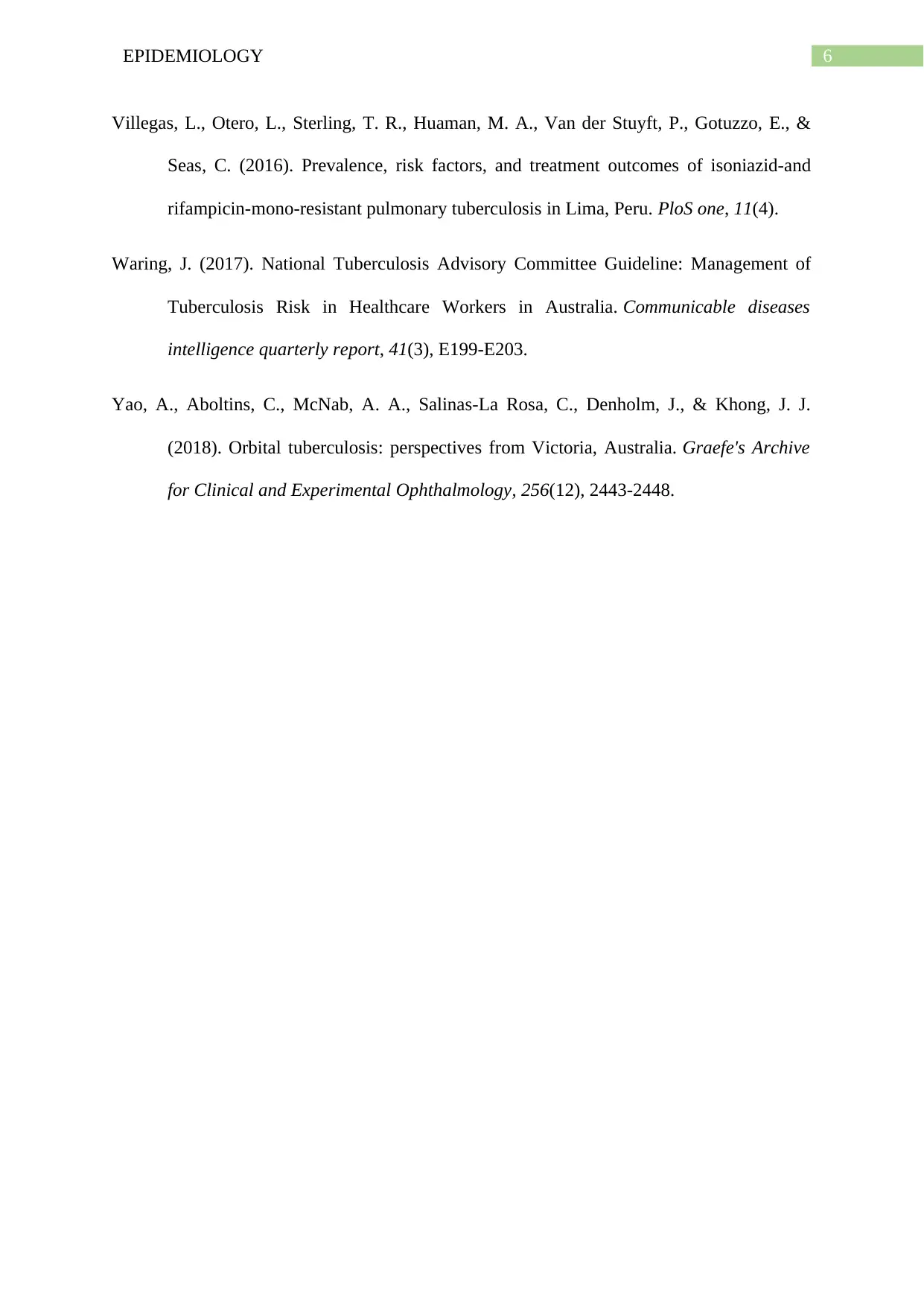
6EPIDEMIOLOGY
Villegas, L., Otero, L., Sterling, T. R., Huaman, M. A., Van der Stuyft, P., Gotuzzo, E., &
Seas, C. (2016). Prevalence, risk factors, and treatment outcomes of isoniazid-and
rifampicin-mono-resistant pulmonary tuberculosis in Lima, Peru. PloS one, 11(4).
Waring, J. (2017). National Tuberculosis Advisory Committee Guideline: Management of
Tuberculosis Risk in Healthcare Workers in Australia. Communicable diseases
intelligence quarterly report, 41(3), E199-E203.
Yao, A., Aboltins, C., McNab, A. A., Salinas-La Rosa, C., Denholm, J., & Khong, J. J.
(2018). Orbital tuberculosis: perspectives from Victoria, Australia. Graefe's Archive
for Clinical and Experimental Ophthalmology, 256(12), 2443-2448.
Villegas, L., Otero, L., Sterling, T. R., Huaman, M. A., Van der Stuyft, P., Gotuzzo, E., &
Seas, C. (2016). Prevalence, risk factors, and treatment outcomes of isoniazid-and
rifampicin-mono-resistant pulmonary tuberculosis in Lima, Peru. PloS one, 11(4).
Waring, J. (2017). National Tuberculosis Advisory Committee Guideline: Management of
Tuberculosis Risk in Healthcare Workers in Australia. Communicable diseases
intelligence quarterly report, 41(3), E199-E203.
Yao, A., Aboltins, C., McNab, A. A., Salinas-La Rosa, C., Denholm, J., & Khong, J. J.
(2018). Orbital tuberculosis: perspectives from Victoria, Australia. Graefe's Archive
for Clinical and Experimental Ophthalmology, 256(12), 2443-2448.
1 out of 7
Related Documents
Your All-in-One AI-Powered Toolkit for Academic Success.
+13062052269
info@desklib.com
Available 24*7 on WhatsApp / Email
![[object Object]](/_next/static/media/star-bottom.7253800d.svg)
Unlock your academic potential
Copyright © 2020–2025 A2Z Services. All Rights Reserved. Developed and managed by ZUCOL.





